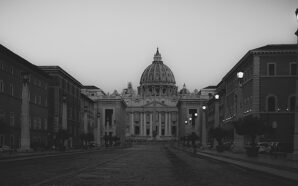Christ and the Woman of Samaria, Benedetto Luti (1666-1724)
While I was still at school, the film adaption of Lloyd Douglas’, The Robe, hit the screen. If I am not mistaken, it was the first film produced in Cinemascope, and cinemas had to build a bigger screen to accommodate it. It was a box office hit starring Richard Burton and Jean Simmons. The fact that Christ’s face was not actually shown (similarly in Ben-Hur) only added to the mystery.
We have all wondered what Jesus looked like. Would I have followed him at first sight? Would his face have elicited an energy that would have swept me off my feet? Would I have left my job if he asked me to?
Many artists have done their best. Perhaps Eastern icons best portray the mystery. I think Benedetto Luti has made a very good attempt. Christ and the Woman of Samaria (c. 1715-1720) is a familiar theme in art. One-on-one encounters with Christ in the Gospels hit a nerve with us. Could the “other” actually be me?
One of the opening lines in the Gospel of St John (John 4:5-42) sets the scene. “Jews, of course, do not associate with Samaritans” (John 4:9). Samaritans were regarded by the Jews as worse than Gentiles. They belonged to the reviled remnant of the ancient Northern Kingdom. They had excluded themselves from Jewish orthodoxy. Moreover, Jesus has crossed the boundary by speaking on intimate terms with a woman. John notes the disciples’ amazement (cf. John 4:27).

Benedetto Luti (Italian, Florence 1666–1724 Rome)
Christ and the Woman of Samaria, 1715–20
Oil on copper; 15 × 12 1/8 in. (38.2 × 30.9 cm). Image: Metropolitan Museum of Art, New York. Rogers Fund, by exchange, 2015. Public Domain.
Jesus knew this woman’s past. He knows my past. He is not so much interested in my sinfulness as he is in my potential to become holy, and my sins are simply getting in the way. This woman is about to become the first ‘apostle’. She converts an entire village. If I can forget my sins and concentrate on my potential, I can become an apostle, too. It is one of Satan’s best-known tactics to remind me of my past, and hence my unworthiness. But, looking at the apostles as my guide, Christ does not call unworthy people and he has called me. Lent is his reminder.
Benedetto Luti was born in Florence in 1666 into a family of artisans. After accepting important commissions in Pisa, Luti settled in Rome, working for many of the city’s greatest families and the pope of the time, Clement XI. He served as advisor in the sale of Queen Christina of Sweden’s collection of paintings. Having converted to Catholicism, she was forced to abdicate her throne, settling thereafter in Rome.
The painting on which we are meditating is an oil on an expensive copper support – suggesting Luti has taken great care with this. He has eliminated all the background of the Gospel account (the apostles going off to the nearby town to buy food) and has concentrated solely on the two people involved. Not only is this a very good-looking Christ, he is totally engaged in his encounter with this woman, as if no one else in the world existed at that moment. It is how he always relates to me, of course. The woman, in her turn, is totally engrossed. She has stopped what she was doing, and hand on the well, is entirely relaxed in her attitude, even as this stranger is revealing the most intimate details of her life.
Jesus is not condemning. He is simply laying out the facts. It is how he treats me in the confessional. To the woman, and to me, he says, “If you only knew what God is offering” (John 4:10). This one line could dominate my prayer time for the rest of Lent.
Monsignor Graham Schmitzer recently retired as the parish priest at Immaculate Conception Parish in Unanderra, NSW.
Republished with permission from the Diocese of Wollongong.








